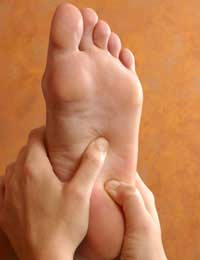What Are Heel Spurs?

If you have a history of foot problems, caused by the painful and degenerative condition plantar fascilitis, you may also develop a heel spur. This usually affects middle-aged men and women, and is a hook of bone that protrudes on the heel bone.
What Causes Heel Spurs?
One of the foot problems that is often associated with plantar fascilitis is a heel spur, which is also known as a calcaneal spur. A heel spur is a hook of bone, or growth of calcium, that forms on the heel bone. This nail-like growth forms around the tendons and ligaments of the foot and grows out of the heel bone and into the flesh of the foot. However, it is not always a painful condition.The cause of this growth is usually the result of an anatomical change of the heel bone (calcaneus), which is often affected by a foot problem or disability of some sort. The calcifying of the soft tissue attachments at the heel bone are generally caused by the body’s reaction to stress and pressure that is put on that area of the foot.
Heel Spurs are also associated with conditions like rheumatoid arthritis, osteoarthritis and other degenerative diseases, although poor blood circulation can also increase the chance of developing this calcium growth.
Symptoms
The heel spur’s close proximity to the tendons of the foot can cause a painful aching sensation to develop over time. Placing additional pressure on the area – by shifting your weight – can also cause considerable pain. Sudden movements, like jumping, can increase the pain also, and continued walking or standing for lengthy periods of time can create tenderness and severe pain.The pain is caused by the inflammation of the tendons, where they are attached to the heel bone, and not due to pressure that is placed directly on the area of the spur. Pain becomes more severe as you walk after a period of resting, as increased demand is made on the foot’s blood vessels and nerves as your foot adjusts to movement.
Treatment Of Heel Spurs
As with many foot problems relief can be provided by elevation of the affected foot. Doing this wherever pain becomes severe can help alleviate the pressure. The application of gentle heat, to the painful area of the foot, will also help as this dilates the blood vessels considerably.Placing a foam rubber pad, cup or cradle in the heel of your shoe can help protect the irritated muscles and tendons that are attached to the heel of your foot. Because the heel pads will raise your heel slightly your body with naturally shift forward, which will result in less pressure being applied to the painful area. Orthotics, which are molds that are designed by foot specialists, will also reduce irritation. Wearing shoes that have a cushioned heel, which absorbs shock, is also recommended.
The application of ultrasound currents will also stimulate blood circulation as it provides a massaging action that alleviates pain in the heel. In very extreme cases however, surgery to remove the heel spur is also another option.
- Walking Aids: Braces & Splints
- Minimising Foot Swelling During Pregnancy
- How to Minimise the Risk of Blisters
- Combating Sweaty Feet
- Shin Splint Pain and Treatment
- Improving Heel Fissures
- Peripheral Edema: Swelling in the Feet and Legs
- Webbed Toes and Treatment
- Fractured Calcanium
- Chilblains and Feet
- Bunions
- Corns: the Causes and Treatments
- In-growing Toenails
- Athlete's Foot
- Blisters
- Calluses
- Verrucas


Re: Footcare and the Housebound
My dad is housebound due to 5 major strokes. He walks with a walker and wears a foot splint. The splint is old, heavy and no longer…
Re: Supportive Feet Products for Senior Citizens
I have a prescription from Dr. at OHSU, but I need some lab to make the Orthodic insoles for my shoes. I was…
Re: How to Get into Foot Modelling
I am female 32yrs of age.I am from south africa I would like to enter into feet and hands modelling industry .I know and I…
Re: The Benefits of a Paraffin Wax Treatment
Hi! Does it cure sweaty palm and feet too?
Re: I have Sharp Pains in My Foot, What could it be?
Recently I have been experiencing a stabbing pain in my left foot,its on the bottom at the back. When I…
Re: Fungal Infections of the Foot and Toenail
I have a constant problem with intense itching on my feet which erupts daily, especially when my feet get warm…
Re: Cosmetic Foot Surgery
I have extremely sweaty feet and it seems to be getting worse. I have perspirex, but it doesnt help. Please help, I don't know what to do…
Re: The Benefits of Foot Massage for Children
One day I came home and my wife said our younger son was having trouble concentrating on his homework. I asked…
Re: Cavus Feet: Symptoms, Causes and Treatments
@sue - I am sorry to hear this. As suggested in the article, arch supports or orthotic devices may be used to…
Re: Cavus Feet: Symptoms, Causes and Treatments
My daughter has cavus feet and has had surgery a few times already. Her surgeon has dismissed her and she is…